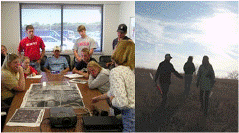Environmental and Sustainability Studies Program

Department of Environmental Studies: Undergraduate Student Theses
Date of this Version
2020
Document Type
Thesis
Citation
Environmental Studies Undergraduate Student Thesis, University of Nebraska-Lincoln, 2020.
Abstract
Red foxes are one of the few creatures able to adapt to living alongside humans as we have evolved. All humans and wildlife have some id of relationship, be it a friendly one or one of mutual hatred, or simply a neutral one. Through a systematic research review of legends, books, and journal articles, I mapped how humans and foxes have evolved together. First, the relationship between humans and foxes in a geographical manner by starting in Asia, moving to Australia and Tasmania, then Europe, Africa, finishing with North and South America. I will be analyzing all the information through a lens to either support or find the fault in a loop similar to the one described in, “A conceptual framework to evaluate human-wildlife interactions within coupled human and natural systems” (Morzillo et al). The loop being is an impact-based feedback loop and describes the ways human behavior is influenced by wildlife. In Asian cultures, the fox spirit can be a benevolent teacher or malevolent bloodthirsty monster. Foxes were first seen as deceitful in Europe with the introduction of Reynard the fox in 1148. The Pale Fox is the center of the Dogon creation myth in Africa. When the Europeans began colonizing Canada and the United States, the fur trade was the first ever contact between the Europeans and the Native People. Then a single domesticated line was created by a Russian geneticist. Today red foxes have been one of the few creatures able to adapt to living in large cities such as Paris, Toronto, and Los Angles. The original question is, to what extent has the relationship between humans and foxes evolved? The uncomplicated answer…substantially.
Included in
Environmental Education Commons, Natural Resources and Conservation Commons, Sustainability Commons


Comments
Copyright 2020 Abigail Misfeldt